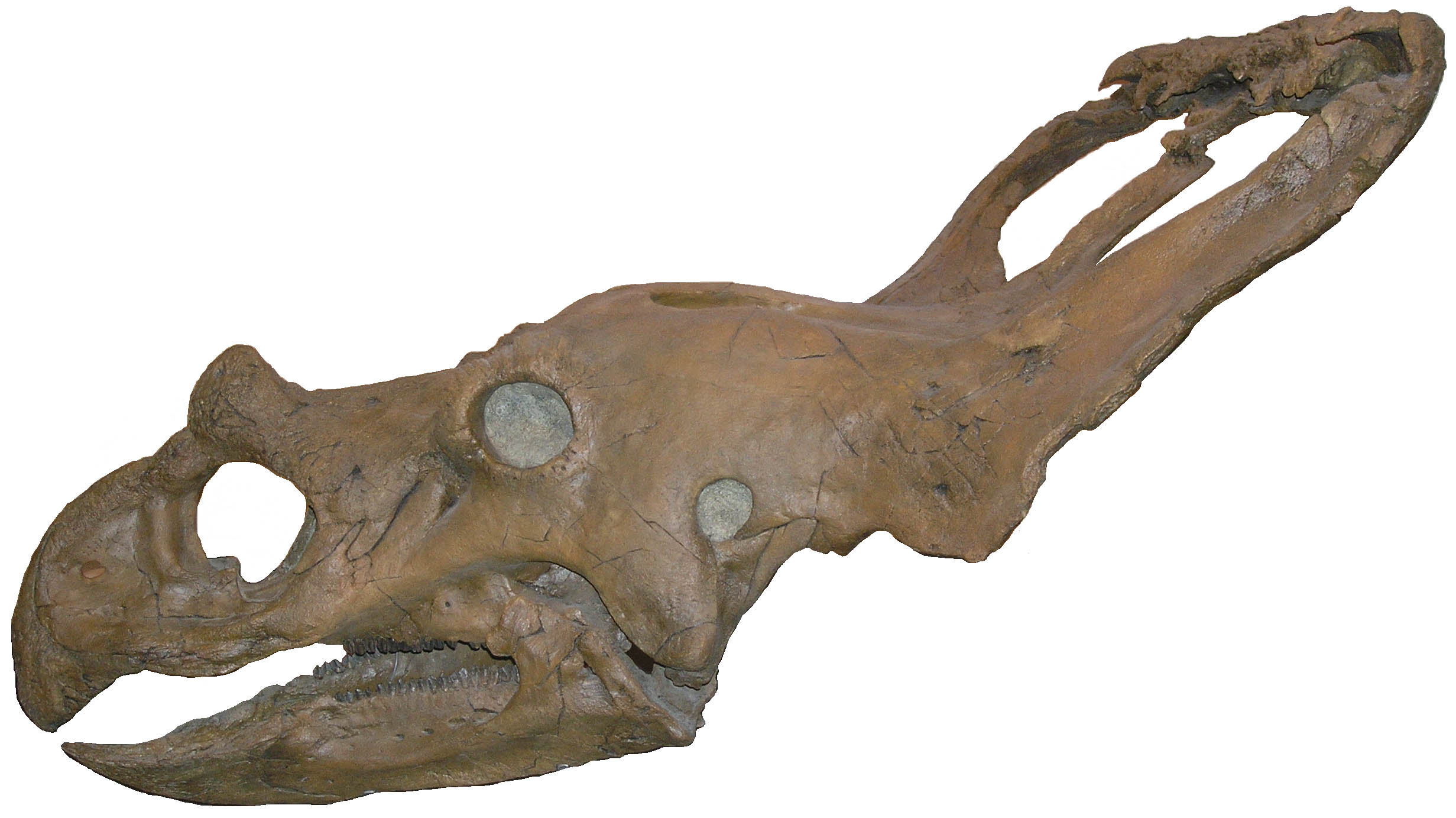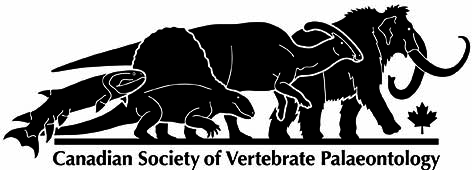Multiple tooth-rowed captorhinids from the Early Permian fissure fills of the Bally Mountain Locality of Oklahoma
DOI:
https://doi.org/10.18435/B5RP4NKeywords:
Moradisaurinae, herbivory, fissure fills, dental anatomy, Captorhinidae, multiple tooth rowsAbstract
Captorhinids were Paleozoic eureptiles that originated in the Late Pennsylvanian in Laurasia and dispersed across the major landmasses of Pangaea by the Late Permian. Their evolutionary success as omnivorous and herbivorous members of Permian terrestrial communities has been attributed to the evolution of multiple marginal tooth rows. Multiple tooth rows evolved at least twice within Captorhinidae: once in the omnivorous Captorhinus aguti and again in the diverse subfamily of herbivorous moradisaurines. The earliest known moradisaurines co-occured with C. aguti in Lower Permian strata of Texas; however C. aguti is also known from much older fissure fills in the famous Dolese Brothers quarry near Richards Spur, Oklahoma, suggesting that C. aguti preceded any other multiple-rowed captorhinid. Here we report on new material of multiple-rowed captorhinids from the Lower Permian fissure fills of the Bally Mountain locality in Oklahoma, only 35 miles from Richards Spur. Some of this material is referrable to Captorhinikos valensis, which was previously only known from younger strata in Texas, making this species the geologically and phylogenetically oldest moradisaurine. Furthermore, we determined that Ca. valensis co-existed with C. aguti at Bally Mountain and we explore the potential for niche partitioning in these early captorhinids. Lastly, we assess the potential temporal and environmental differences between Bally Mountain and Richards Spur, in order to explain the abundance of herbivorous moradisaurines at Bally Mountain and the complete lack of moradisaurines at the neighbouring Richards Spur locality.
Downloads
References
Benton, M. J. 1984. Tooth form, growth, and function in Triassic rhynchosaurs (Reptilia, Diapsida). Palaeontology 27:737–776.
Bolt, J. R., and R. E. Demar. 1975. An explanatory model of the evolution of multiple rows of teeth in Captorhinus aguti. Journal of Paleontology 49:814–832.
Busbey, A. B. 1990. The Bally Mountain Lower Permian vertebrate locality, Kiowa Co., Oklahoma. Journal of Vertebrate Paleontology 10 (Supplement to number 3):16A.
Case, E. C. 1911. A revision of the Cotylosauria of North America. Carnegie Institution of Washington Publication 145:1–122.
Dodick, J. T., and S. P. Modesto. 1995. The cranial anatomy of the captorhinid reptile Labidosaurikos meachami from the Lower Permian of Oklahoma. Palaeontology 38:687–711.
Donovan, R. N. 1987. The world’s smallest oil field? Oklahoma Geology Notes 47:238 & 291.
Fox, R. C., and M. C. Bowman. 1966. Osteology and relationships of Captorhinus aguti (Cope) (Reptilia: Captorhinomorpha). The University of Kansas Paleontological Contributions, Vertebrata 11:1–79.
Heaton, M. J. 1979. Cranial anatomy of primitive captorhinid reptiles from the Late Pennsylvanian and Early Permian Oklahoma and Texas. Oklahoma Geological Survey Bulletin 127:1–84.
Kissel, R. A., D. W. Dilkes, and R. R. Reisz. 2002. Captorhinus magnus , a new captorhinid (Amniota: Eureptilia) from the Lower Permian of Oklahoma, with new evidence on the homology of the astragalus. Canadian Journal of Earth Sciences 39:1363–1372.
LeBlanc, A. R. H., and R. R. Reisz. 2015. Patterns of tooth development and replacement in captorhinid reptiles: a comparative approach for understanding the origin of multiple tooth rows. Journal of Vertebrate Paleontology e919928.
Linnaeus, C. 1758. Systema Naturae per Regna Tria Naturae, Secundum Classes, Ordines, Genera, Species, Cum Characteribus, Differetiis, Synonymis, Locis, Editio X. Salvii, Stockholm, 824 pp.
Macdougall, M. J., and R. Reisz. 2012. A new parareptile (Parareptilia, Lanthanosuchoidea) from the Early Permian of Oklahoma. Journal of Vertebrate Paleontology 32:1018–1026.
May, W. J., and R. L. Cifelli. 1998. Baeotherates fortsillensis, a new captorhinid reptile from the Fort Sill fissures. Oklahoma Geology Notes 58:128–137.
Modesto, S. P. 1996. A basal captorhinid reptile from the Fort Sill fissures, Lower Permian of Oklahoma. Oklahoma Geology Notes 56:4–14.
Modesto, S. P. 1998. New information on the skull of the Early Permian reptile Captorhinus aguti. PaleoBios 18:21–35.
Modesto, S. P., A. J. Lamb, and R. R. Reisz. 2014. The captorhinid reptile Captorhinikos valensis from the lower Permian Vale Formation of Texas, and the evolution of herbivory in eureptiles. Journal of Vertebrate Paleontology 34:291–302.
Modesto, S. P., D. M. Scott, D. S. Berman, J. Müller, and R. R. Reisz. 2007. The skull and the palaeoecological significance of Labidosaurus hamatus, a captorhinid reptile from the Lower Permian of Texas. Zoological Journal of the Linnean Society 149:237–262.
Müller, J., and R. R. Reisz. 2005. An early captorhinid reptile (Amniota, Eureptilia) from the Upper Carboniferous of Hamilton, Kansas. Journal of Vertebrate Paleontology 25:561–568.
O’Keefe, F. R., C. A. Sidor, H. C. E. Larsson, A. Maga, and O. Ide. 2005. The vertebrate fauna of the Upper Permian of Niger—III, morphology and ontogeny of the hindlimb of Moradisaurus grandis (Reptilia, Captorhinidae). Journal of Vertebrate Paleontology 25:309–319.
Olson, E. C. 1952. The Evolution of a Permian Vertebrate Chronofauna. Evolution 6:181.
Olson, E. C. 1954. Fauna of the Vale and Choza: 9. Captorhinomorpha. Fieldiana: Geology 10:211–218.
Reisz, R. R. 1997. The origin and early evolutionary history of amniotes. Trends in Ecology and Evolution 12:218–222.
Reisz, R. R. 2005. Oromycter , a new caseid from the Lower Permian of Oklahoma. Journal of Vertebrate Paleontology 25:905–910.
Reisz, R. R. 2006. Origin of dental occlusion in tetrapods: signal for terrestrial vertebrate evolution? Journal of Experimental Zoology Part B: Molecular and Developmental Evolution 306B:261–277.
Reisz, R. R., and T. E. Sutherland. 2001. A diadectid (Tetrapoda: Diadectomorpha) from the Lower Permian fissure fills of the Dolese Quarry, near Richards Spur, Oklahoma. Annals of the Carnegie Museum 70:133–142.
Reisz, R. R., and J. Fröbisch. 2014. The Oldest Caseid Synapsid from the Late Pennsylvanian of Kansas, and the Evolution of Herbivory in Terrestrial Vertebrates. PLoS ONE 9:e94518.
Reisz, R. R., V. Barkas, and D. Scott. 2002. A new early Permian bolosaurid reptile from the Richards Spur Dolese Brothers Quarry, near Fort Sill, Oklahoma. Journal of Vertebrate Paleontology 22:23–28.
Reisz, R. R., J. Liu, J.-L. Li, and J. Müller. 2011. A new captorhinid reptile, Gansurhinus qingtoushanensis, gen. et sp. nov., from the Permian of China. Naturwissenschaften 98:435–441.
Ricqlès, A. de, and P. Taquet. 1982. La faune de vertebres de Permien Supérieur du Niger. I. Le captorhinomorphe Moradisaurus grandis (Reptilia, Cotylosauria)–le crane. Annales de Paléontologie 68:33–63.
De Ricqlès, A., and J. R. Bolt. 1983. Jaw growth and tooth replacement in Captorhinus aguti (Reptilia: Captorhinomorpha): a morphological and histological analysis. Journal of Vertebrate Paleontology 3:7–24.
Simpson, L. C. 1979. Upper Gearyan and Lower Leonardian terrestrial vertebrate faunas of Oklahoma. Oklahoma Geology Notes 39:3–19.
Sullivan, C., and R. R. Reisz. 2002. Lower Permian fissure deposits in the Slick Hills, Oklahoma, the oldest known fossiliferous palaeokarst. Journal of Vertebrate Paleontology 22 (Supplement to 3):112A.
Swofford, D. L. 2002. Phylogenetic Analysis Using Parsimony (*And Other Methods). Sinaeur Associates, Sunderland, Massachusetts, pp.
Woodhead, J., R. Reisz, D. Fox, R. Drysdale, J. Hellstrom, R. Maas, H. Cheng, and R. L. Edwards. 2010. Speleothem climate records from deep time? Exploring the potential with an example from the Permian. Geology 38:455–458.
Downloads
Published
How to Cite
Issue
Section
License
Copyright (c) 2014 Aaron R. H. LeBlanc, Amanpreet K Brar, William J May, Robert R Reisz

This work is licensed under a Creative Commons Attribution 4.0 International License.
Submission of an article to Vertebrate Anatomy Morphology Palaeontology will be taken to mean that the article is an original work and not previously published or under consideration for publication elsewhere.
If the article is accepted for publication, it will be published on-line under Creative Commons Attribution 4.0 International (CC By 4.0) meaning:
Attribution — You must give appropriate credit, provide a link to the license, and indicate if changes were made. You may do so in any reasonable manner, but not in any way that suggests the licensor endorses you or your use.
No additional restrictions — You may not apply legal terms or technological measures that legally restrict others from doing anything the license permits.







